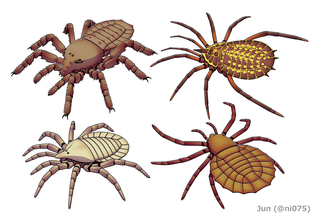
Paleontology, also spelled palaeontology or palæontology, is the scientific study of life that existed prior to, and sometimes including, the start of the Holocene epoch. It includes the study of fossils to classify organisms and study their interactions with each other and their environments. Paleontological observations have been documented as far back as the 5th century BCE. The science became established in the 18th century as a result of Georges Cuvier's work on comparative anatomy, and developed rapidly in the 19th century. The term itself originates from Greek παλα'palaios, "old, ancient", ὄν, on, "being, creature", and λόγος, logos, "speech, thought, study".

Chilognatha is a subclass of the class Diplopoda, which includes the vast majority of extant millipede, about 12,000 species.

Samuel Hubbard Scudder was an American entomologist and paleontologist. He was a leading figure in entomology during his lifetime and the founder of insect paleontology in America. In addition to fossil insects, he was an authority on butterflies (Lepidoptera) and grasshoppers (Orthoptera).

The order Trigonotarbida is a group of extinct arachnids whose fossil record extends from the late Silurian to the early Permian. These animals are known from several localities in Europe and North America, as well as a single record from Argentina. Trigonotarbids can be envisaged as spider-like arachnids, but without silk-producing spinnerets. They ranged in size from a few millimetres to a few centimetres in body length and had segmented abdomens (opisthosoma), with the dorsal exoskeleton (tergites) across the backs of the animals' abdomens, which were characteristically divided into three or five separate plates. Probably living as predators on other arthropods, some later trigonotarbid species were quite heavily armoured and protected themselves with spines and tubercles. About seventy species are currently known, with most fossils originating from the Carboniferous coal measures. In July 2014 scientists used computer graphics to re-create a possible walking gait for the animal. However, a subsequent biomechanical analysis proved the proposed coordination pattern as largely non-physiological.

Robert Etheridge was a British palaeontologist who made important contributions to the Australian Museum.
Paleontology or palaeontology is the study of prehistoric life forms on Earth through the examination of plant and animal fossils. This includes the study of body fossils, tracks (ichnites), burrows, cast-off parts, fossilised feces (coprolites), palynomorphs and chemical residues. Because humans have encountered fossils for millennia, paleontology has a long history both before and after becoming formalized as a science. This article records significant discoveries and events related to paleontology that occurred or were published in the year 1987.

Diplichnites are arthropod trackways with two parallel rows of blunt to elongate, closely spaced tracks oriented approximately perpendicularly to the mid-line of the trackway. The term is more often used for the ichnofossils of this description; however, similar trackways from recent arthropods are sometimes given this name as well.

Euthycarcinoidea are an enigmatic group of extinct possibly amphibious arthropods that ranged from Cambrian to Triassic times. Fossils are known from Europe, North America, Argentina, Australia and Antarctica.
Paleontology or palaeontology is the study of prehistoric life forms on Earth through the examination of plant and animal fossils. This includes the study of body fossils, tracks (ichnites), burrows, cast-off parts, fossilised feces (coprolites), palynomorphs and chemical residues. Because humans have encountered fossils for millennia, paleontology has a long history both before and after becoming formalized as a science. This article records significant discoveries and events related to paleontology that occurred or were published in the year 1970.
Paleontology or palaeontology is the study of prehistoric life forms on Earth through the examination of plant and animal fossils. This includes the study of body fossils, tracks (ichnites), burrows, cast-off parts, fossilised feces (coprolites), palynomorphs and chemical residues. Because humans have encountered fossils for millennia, paleontology has a long history both before and after becoming formalized as a science. This article records significant discoveries and events related to paleontology that occurred or were published in the year 1968.
Paleontology or palaeontology is the study of prehistoric life forms on Earth through the examination of plant and animal fossils. This includes the study of body fossils, tracks (ichnites), burrows, cast-off parts, fossilised feces (coprolites), palynomorphs and chemical residues. Because humans have encountered fossils for millennia, paleontology has a long history both before and after becoming formalized as a science. This article records significant discoveries and events related to paleontology that occurred or were published in the year 1910.
Paleontology or palaeontology is the study of prehistoric life forms on Earth through the examination of plant and animal fossils. This includes the study of body fossils, tracks (ichnites), burrows, cast-off parts, fossilised feces (coprolites), palynomorphs and chemical residues. Because humans have encountered fossils for millennia, paleontology has a long history both before and after becoming formalized as a science. This article records significant discoveries and events related to paleontology that occurred or were published in the year 1878.
Paleontology or palaeontology is the study of prehistoric life forms on Earth through the examination of plant and animal fossils. This includes the study of body fossils, tracks (ichnites), burrows, cast-off parts, fossilised feces (coprolites), palynomorphs and chemical residues. Because humans have encountered fossils for millennia, paleontology has a long history both before and after becoming formalized as a science. This article records significant discoveries and events related to paleontology that occurred or were published in the year 1890.
Paleontology or palaeontology is the study of prehistoric life forms on Earth through the examination of plant and animal fossils. This includes the study of body fossils, tracks (ichnites), burrows, cast-off parts, fossilised feces (coprolites), palynomorphs and chemical residues. Because humans have encountered fossils for millennia, paleontology has a long history both before and after becoming formalized as a science. This article records significant discoveries and events related to paleontology that occurred or were published in the year 1877.
Paleontology or palaeontology is the study of prehistoric life forms on Earth through the examination of plant and animal fossils. This includes the study of body fossils, tracks (ichnites), burrows, cast-off parts, fossilised feces (coprolites), palynomorphs and chemical residues. Because humans have encountered fossils for millennia, paleontology has a long history both before and after becoming formalized as a science. This article records significant discoveries and events related to paleontology that occurred or were published in the year 1879.

Prodryas persephone is an extinct species of brush-footed butterfly, known from a single specimen from the Chadronian-aged Florissant Shale Lagerstatte of Late Eocene Colorado. P. persephone is the first fossil butterfly to be found in North America, and is exquisitely well preserved. Its closest extant relatives are the mapwings and African admirals of the genera Hypanartia and Antanartia, respectively.

The Allenby formation is a sedimentary rock formation deposited during the early to early Middle Eocene. It consists of conglomerates, sandstones with interbedded with shales and coal. The coal seams contain an abundance of insect, fish and plant fossils, known from the shales since 1877 but best known from the Princeton Chert.

Archipolypoda is an extinct group of millipedes known from fossils in Europe and North America and containing the earliest known land animals. The Archipolypoda was erected by Scudder (1882) but redefined in 2005 with the description of several new species from Scotland. Distinguishing characteristics include relatively large eyes with densely packed ocelli, and modified leg pairs on the 8th body ring. Some species had prominent spines while others had a flattened appearance.

Aphaenogaster longaeva is an extinct species of ant in formicid subfamily Myrmicinae known from a solitary Eocene or Oligocene fossil found in North America. A. longaeva was one of five insect species described by the paleoentomologist Samuel Hubbard Scudder in an 1877 paper.
Rosamygale is a genus of extinct Triassic spiders, with a single described species, Rosamygale grauvogeli. It is the oldest known member of the Mygalomorphae, one of the three main divisions of spiders, which includes well known forms such as tarantulas and Australian funnel-web spiders. It was described by Selden and Gall in 1992, from specimens found in the Middle Triassic aged Gres a Meules and Grès à Voltzia geological formations in France. It is also considered to be the oldest known member of the Avicularioidea, one of the two main divisions of Mygalomorphae.
























